2 中国科学院南京地质古生物研究所, 江苏 南京 210008)
新生代以来全球气候阶段性持续变冷,第四纪时北半球冰量扩张,这在深海氧同位素记录中得到很好的体现[1]。新生代以来的强烈构造运动、海陆格局的改变,使大气环流系统调整,尤其是山地或高原的剧烈隆升、大气CO2含量降低、气候带移动,导致气候的纬度地带性趋于明显,季风形成或加强。亚洲季风形成、演化及其驱动机制一直以来都是学术界研究的重点。我国学者利用已有的地质生物记录对亚洲季风起源[2~8]、演化过程[9~12]、驱动机制[6, 13~16]等问题展开研究并取得了重要成果。同时,尚有科学问题没有得到解决,比如季风气候的阶段性演化、变率特征、植被对季风气候变化的响应和定量重建等,仍需要开展更多的研究。
渭河盆地是发育于秦岭造山带北麓的新生代断陷盆地,沉积厚度约7000 m,其南缘蓝田、渭南地区发育有完整的新生代连续沉积。作为中国南北方分界线,秦岭南北两侧的气候和植被有明显的变化,这个区域的植被对气候变化响应敏感。因此,渭河盆地沉积序列为研究新生代植被演化历史,探究植被和气候的阶段性变化特征提供了良好的材料。孢粉能直接反映植被的变化,记录植被演化过程,对恢复古气候、古环境具有不可替代的作用[17~19]。对欧洲大陆[20]、哥伦比亚和委内瑞拉西部地区[21]、南美洲阿根廷巴塔哥尼亚地区[22]新生代孢粉研究,发现新生代植被演化与深海氧同位素揭示的全球古气候变化具有一致性。我国的新生代孢粉研究由早期的反映植物群演化[23~24],向探究季风演化[9]、古气候定量重建[25~26]、古海拔重建[27]等科学问题转化。渭河盆地作为我国开展晚新生代孢粉学研究较早的地区之一,早在1964年“陕西蓝田新生界现场会议”[28]前后,对更新世张家坡剖面、渭南北庄村剖面、蓝田涝池河剖面进行了孢粉分析和古植被、古气候重建,对中新世的寇家村组寇家村剖面和灞河组的水家嘴剖面的孢粉种类进行了初步分析。之后,石油部门对汾渭盆地进行石油普查时在渭南张家河白鹿塬组、渭南张家河冷水沟组和渭南沋河三门组地层中均发现孢粉化石[29]。本文通过对已有渭河盆地的花粉研究资料进行集成,结合对晚中新世灞河组孢粉分析的结果,重建了渭河盆地新生代以来的古植被、古气候变化,以此来反映季风气候的阶段性变化。
1 研究区概况 1.1 自然地理概况渭河盆地又名关中盆地或关中平原,位于陕西省中部,介于秦岭和渭北平原之间,北邻鄂尔多斯高原,南接秦岭,东到三门峡,西到宝鸡(图 1)。东西长300~400 km,南北宽30~80 km,东宽西窄,整体NE走向,平面形状似弯月,面积约3.6×104 km2[30~31]。
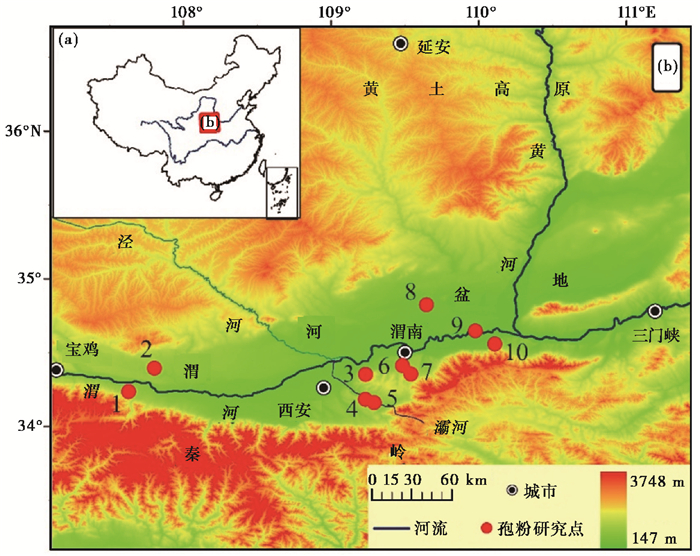
|
图 1 研究区位置(a)及主要孢粉研究点分布(b) 1.岐山(Qishan);2.新店(Xindian);3.阎村(Yancun);4.段家坡(Duanjiapo);5.蓝田水库(Lantian Reservoir);6.南姜村(Nanjiangcun);7.北庄村(Beizhuangcun);8.卤阳湖(Luyanghu);9.史家湾(Shijiawan);10.华阴(Huayin) Fig. 1 Location(a)of study area and distribution(b) of major spore-pollenresearch sites |
渭河盆地位于暖温带季风气候区,冬季寒冷、夏季炎热,四季分明。年平均气温是12~14 ℃,极端最低气温在- 18~- 16 ℃,极端最高气温达到43 ℃。最冷月(1月)月平均气温在- 2~0 ℃之间,最热月(7月)月平均气温在25~26 ℃之间,春季4月天气逐渐回暖,秋季10月气温开始转凉。年平均降水量为500~800 mm;降水年内分配不均,3~9月份降水量占全年降水量85 %以上。最大平均湿度出现在8月、9月份,最小平均湿度出现在1月、2月份,年相对湿度高于60 %。
研究区植被类型属于暖温带落叶阔叶林,主要植被类型有针叶林、针阔混交林、阔叶林、灌丛、草丛草甸[32](图 2)。针叶林主要包括松(Pinus)林、侧柏(Platycladus orientalis)林和杉(Cunninghamia R. Br.)林;针阔叶混交林主要是华山松(Pinus armandii)、铁杉(Tsuga chinensis)与山杨(Populus davidiana)、栓皮栎(Quercus variabilis)等针、阔叶树混生;阔叶林主要是桦(Betula)林和栎(Quercus)林,还有一些杨树(Populus L.)林、刺槐(Robinia pseudoacacia L.)林、旱柳(Salix matsudana Koidz)林等;灌丛类型较多,主要是胡枝子(Lespedeza bicolor)灌丛,胡颓子(Elaeagnus pungens Thunb.)、柳(Salix)灌丛,虎榛子(Ostryopsis davidiana Decaisne)灌丛,黄栌(Cotinus coggygria Scop.)灌丛,蔷薇(Rosa sp.)灌丛,秦岭小檗(Berberis circumserrata)灌丛,山杏(Armeniaca sibirica(L.)Lam)灌丛,头花杜鹃(Rhododendron capitatum Maxim.)、百里香杜鹃(Rhododendron thymifolium Maxim.)灌丛,圆锥绣球(Hydrangea paniculata Sieb. et Zucc.)灌丛,绣线菊(Spiraea salicifolia L.)灌丛,榛子(Corylus hetero Phella))灌丛等;草丛、草甸主要涵盖了白羊草(Bothriochloa ischaemum (L.)Keng.)草丛,金茅(Eulalia speciosa(Debeaux))、野古草(Arundinella anomala Steud.)、青香茅(Cymbopogon caesius(Nees ex Hook. et Arn.)Stapf)草丛,酸枣(Ziziphus jujuba Mill. var. spinosa(Bunge)Hu ex H. F. Chow)、黄背草(Themeda triandra)灌草丛,罗布麻(A.venetum L.)草甸,杂草草甸,圆穗蓼(Polygonum macrophyllum D. Don)、珠芽蓼(Polygonum viviparum L.)草甸,狗牙根(Cynodon dactylon(L.)Pers.)草甸等。另外,渭河盆地农业生产发展较早,是人类活动的主要场所,植被面貌受到人类耕作影响,在平原及黄土台塬上垦种,自然植被已被破坏,栽培植被广泛分布,主要农作物类型是小麦、玉米等粮食作物和苹果、梨等经济作物。
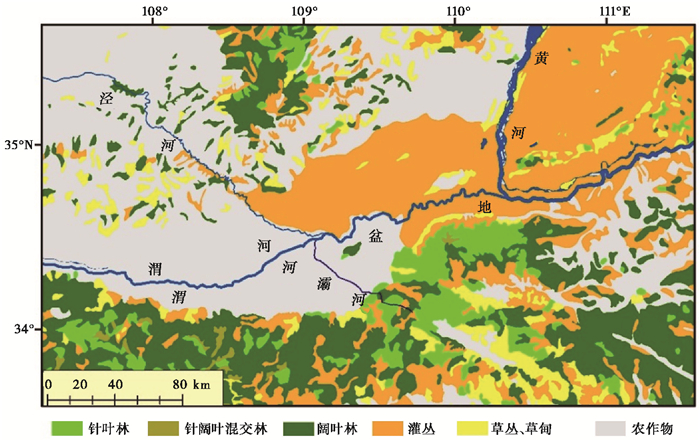
|
图 2 研究区植被图 以《中华人民共和国植被图(1 : 1000000)》[32]为底图绘制 Fig. 2 Vegetationmap of the research area, based on "Vegetation Map of the People's Republic of China(1 : 10, 000, 000)"[32] |
根据前人的研究[31, 33~43]并结合我们多次野外考察结果,将蓝田及渭南地区新生界地层进行了梳理,依次分为:红河组、白鹿塬组、冷水沟组、寇家村组、灞河组、蓝田组和三门组。图 3的地层剖面分别为红河组下韩村剖面、白鹿塬组支家沟剖面、冷水沟组-寇家村组毛东村剖面、灞河组水吴村剖面、蓝田组苌沟村剖面、三门组张家坡剖面。
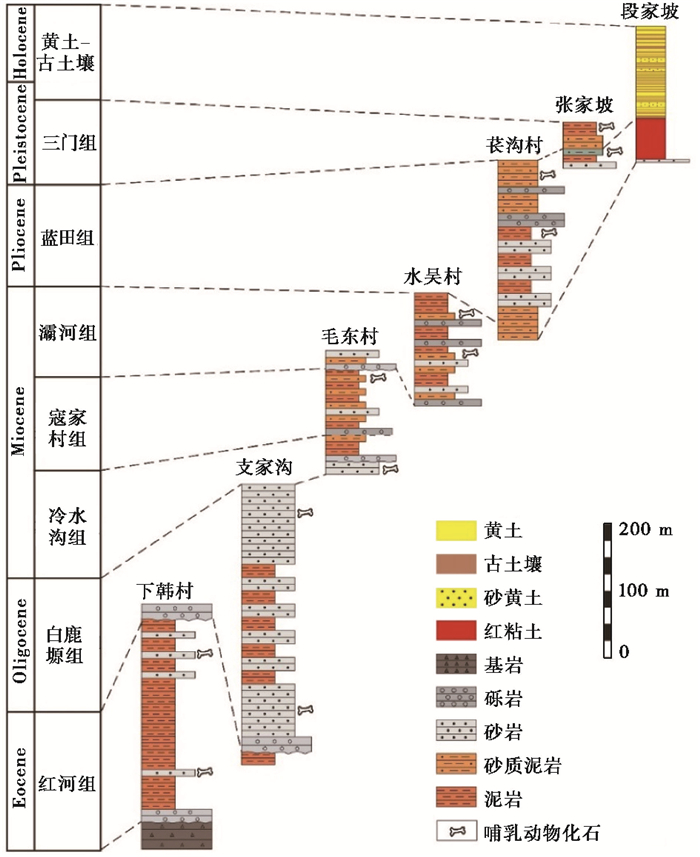
|
图 3 蓝田及渭南地区新生界地层1) Fig. 3 TheCenozoic stratigraphy of Lantian and Weinan1) |
1) Lu Huayu,Sun Xuefeng,Ma Chunmei,et al. Field Trip Guide. Nanjing University-Freie Universität Berlin Double Degree Master's Program,Environmental Earth Sciences,2017:1-42. Unpublished field trip guide
古近系包括红河组和白鹿塬组。红河组为紫红色泥岩夹黄色、灰绿色砂岩,岩性较细,为河湖相沉积。代表剖面是陕西蓝田支家沟上游,厚约330 m,红河组时代定为中始新世晚期-晚始新世[35~36, 42];白鹿塬组为灰白色厚层块状砂岩夹棕红色粉砂质泥岩,为河流相沉积。典型剖面是蓝田支家沟,厚约400 m,白鹿塬组地层时代应为晚始新世-早渐新世[33, 35~36, 42]。
新近系包括冷水沟组、寇家村组、灞河组和蓝田组。冷水沟组为黄棕色、棕红色砂岩,粗砂岩与暗紫红色泥岩互层,为河湖相沉积[35~36, 38],代表剖面在蓝田冷水沟,厚度约70 m,冷水沟组时代定为中中新世[35~36];寇家村组为棕黄色泥岩、砂质泥岩与砂岩互层,底部常有块状砂砾岩,典型剖面在西安-蓝田交界地区的白鹿塬毛东村,厚100 m,寇家村组时代定为晚中新世[35~36];灞河组地层在白鹿塬地区广泛分布,不整合覆盖于寇家村组之上,在顶部以一层2~3 m厚的砂砾石层与上覆蓝田组不整合接触,代表性剖面位于灞河左岸的水吴村,厚度约183 m,分上、中、下共3段,上段为红棕色含砾泥岩、砂质泥岩与含砾砂岩互层,中段为一套灰绿色泥岩和红褐色泥岩互层沉积,下段主要为砂砾岩、砂岩与含砾泥岩或砂质泥岩互层,夹红棕色泥岩层,时代为晚中新世[31, 35~36];蓝田组为棕红色粉砂质泥岩、黄色粉砂岩与砂岩互层,代表剖面为渭南苌沟村剖面,深度为268 m,年代为晚中新世-上新世1),与灞河左岸白鹿塬水吴村红粘土序列为同期异相沉积。
1) Wang Yichao,Lu Huayu,Wang Kexin,et al. High- and low-latitude forcing of Asian monsoon precipitation during the Late Miocene to Pliocene:Evidence from a fluvial-lacustrine record in Weihe Basin,Central China [J]. Earth and Planetary Science Letters,2018,Under review
第四系三门组岩性以黄土和砂砾卵石为主,上段以棕黄、灰黄色砂岩、粉砂岩为主,下段以灰绿色、灰白色粉砂岩为主,广泛分布于渭河平原地表之下,出露于河谷地段,代表剖面为渭南沋河张家坡-芦家壕剖面,与蓝田段家坡第四纪黄土-古土壤序列为同期异相沉积。
2 渭河盆地新生代孢粉记录的植被、气候演化渭河盆地新生代沉积序列接受盆地周边、秦岭及邻近大气传播与水流携带的孢子和花粉,沉积在低洼积水处或湖泊中,成为孢粉化石。因此,我们所研究的孢粉化石是渭河盆地及其四周的区域植被的记录。
始新世红河组地层尚未找到可用的孢粉数据,因此我们主要参考了同时代的河南灵宝项城组的孢粉数据[29],代表剖面是西涧河剖面,剖面深度约1146 m,选择该地层中样品9个,对应图 4样品编号26~34。白鹿塬组地层孢粉数据主要来自渭南沋河上游张家河村剖面[29],由于该层孢粉样品仅一个(对应图 4样品编号25),因此在分析白鹿塬组的古植被、古气候变化时参考渭河盆地井下同时代的户县群孢粉结果[44]。冷水沟组地层孢粉数据主要来自沋河张家河村剖面[29],剖面厚度约123 m,该层孢粉样品2个(对应图 4样品编号23、24),因此在分析冷水沟组的古植被、古气候变化时参考渭南樊家滩冷水沟组孢粉分析结果[44];灞河组地层剖面位于灞河左岸的水吴村,厚度约183 m,分析该地层样品5个,对应图 4样品编号18~22;上新世地层蓝田组孢粉数据来自沋河张家坡剖面[29],厚度约220 m,对应图 4样品编号5~17;更新世地层三门组孢粉数据(图 4样品编号1~4)主要是渭河盆地更新世钻井孢粉数据[29]。
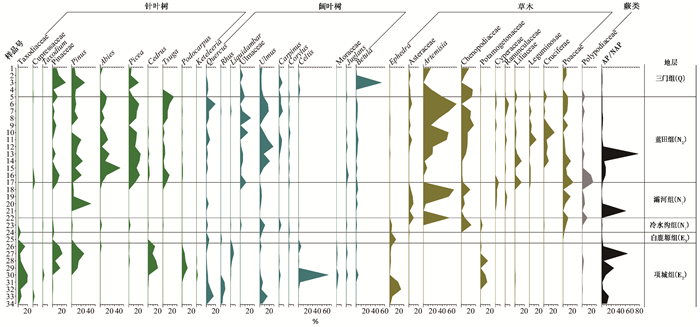
|
图 4 渭河盆地新生代主要孢粉类型百分比图谱 其中项城组(红河组地层无孢粉数据,以卢氏盆地项城组为例)、白鹿塬组、冷水沟组、蓝田组、三门组数据引自文献[29];灞河组数据为本研究结果,寇家村组无孢粉数据 Fig. 4 Sporo-pollen percentage diagram of the Weihe Basin since the Cenozoic and data of Xiangcheng Formation(we have no sporo-pollen data for Honghe Formation, then we use the pollen data of Xiangcheng Formation in Lushi Basin), Bailuyuan Formation, Lengshuigou Formation, Lantian Formation and Sanmen Formation from reference [29], Bahe Formation from this study and we have no sporo-pollen data for Koujiacun Formation |
始新世孢粉组合中热带、亚热带阔叶树花粉含量较高[29],其中漆树属(Rhus)花粉占2.8 % ~9.5 %,枫香树属(Liquidambar)占0.4 % ~6.9 %,黄杞属(Engelhardia)为0.6 % ~1.7 %,五加科(Araliaceae)为0.6 % ~3.0 %,大戟科(Euphorbiaceae)为0.6 % ~0.7 % (表 1)。旱生草本花粉含量很低,主要有豆科(Fabaceae)、蔷薇科(Roaceae)为主。始新世植被群以含热带亚热带乔木成分的落叶阔叶林为主,如漆树属、枫香属、黄杞属、大戟科,这些植物多为热带、亚热带落叶阔叶树或常绿阔叶树种,喜温暖湿润气候。另外,该阶段罗汉松属(Podocarpus)含量很高,最高达到12 %。罗汉松为常绿针叶乔木,喜温暖湿润气候,生长在年均温为15~16 ℃,降水量1500 mm左右的地区,因此推断始新世降水和温度都很高,气候暖湿。
| 表 1 渭河盆地新生代以来主要热带-亚热带乔木花粉种类及含量(+:含量较低) Table 1 Pollen species and the content of mainly tropical and subtropical trees in the Weihe Basin since Cenozoic(+:low content) |
早渐新世时阔叶树种花粉占绝对优势,如表 1所示,有亚热带成分的楝属(Melia,10 %)、大戟科(5 %)、芸香属(Ruta,3 %)、山核桃属(Carya)等,还出现温带落叶阔叶树花粉,如栎属(Quercus)、榆属(Ulmus)等[29, 44],针叶树种含量很低,植被为含常绿树种的落叶阔叶林,气候暖热湿润。对井下地层户县群孢粉[44]分析,显示中晚渐新世时水生植物花粉含量增加,阔叶树花粉榆属、山核桃属、栎属、椴属(Tilia)、昆栏树属(Trochodendron)等较高,后期麻黄属(Ephedra)、藜科(Chenopodiaceae)及耐干旱的松属(Pinus)、喜冷湿的云杉属(Picea)花粉含量增加,此时段的植被是以榆属、松属、山核桃属、落叶栎属、椴属等为主的针阔叶混交林,前期暖热稍湿润,后期温暖干燥。渐新世地层中出现一些热带-亚热带乔木树种,如楝属、大戟科、昆栏树属。楝树喜温暖湿润气候,喜光,不耐庇荫,较耐寒;大戟喜温暖湿润气候,耐旱、耐寒喜潮湿;昆栏树为常绿灌木或小乔木,分布区气候温暖或温凉湿润,主要集中在我国的台湾地区。根据渐新世出现热带-亚热带植被组成,推测气候暖热稍湿润。另外,渐新世热带-亚热带植被含量比始新世有所降低(图 4),渐新世气温、降水与始新世相比略有降低。
2.2 渭河盆地新近纪孢粉、植被组成及气候演化对渭南沋河上游张家河村剖面及渭南樊家滩冷水沟组进行孢粉分析[29, 44],结果显示早中中新世孢粉以榆属、山核桃属、榛属(Corylus)等为主,其次是旋花科(Convolvulaceae)、藜科、禾本科(Poaceae)、菊科(Asteraceae)、石竹科(Caryophyllaceae)等(图 4)。植被以落叶阔叶林为主,含较多草本植物,尤其是出现较多水生植物菱属(Trapa)花粉,表明当时气候温暖湿润,此时植被无热带树种,亚热带树种类和数量均降低,表明气候比渐新世要干凉。
根据近几年我们对渭河盆地灞河组地层孢粉进行分析,选择同一孢粉带不同沉积相及不同孢粉带的相同沉积相的花粉数据进行对比,结果显示在相同孢粉带内,不同岩性样品的花粉百分含量相似,但花粉浓度相差很大,泥岩花粉浓度大于粉砂岩、砂岩的花粉浓度,砾岩中花粉浓度变化较大;在不同孢粉带内,岩性与沉积相都相似的样品花粉百分比含量和花粉浓度都存在很大差异。整体来说,灞河组花粉百分比含量能够较好的反映区域古植被和古气候信息。整个灞河组地层阔叶树花粉如常绿栎属(Quercus-evergreen)、落叶栎属(Quercus-deciduous)、栲属(Castanopsis)、枫杨属(Pterocarya)等含量较低,草本植物花粉含量较高,主要以菊科、蒿属(Artemisia)、藜科、禾本科为主。对渭河盆地灞河组晚中新世孢粉数据的古气候古植被重建结果显示,在11.0~7.0 Ma阶段,整体上是温暖湿润气候,中间伴随着次级干湿波动,其中在11.0~10.0 Ma,植被类型主要以森林为主,依次出现落叶阔叶林和针阔混交林;10 Ma之后转化为草原,气候由暖湿转为暖干1)。Kaakinen等[45]对灞河组碳酸盐进行了碳氧同位素分析,指示了当时沉积环境较稳定,为森林草原环境,这与我们植被重建结果基本一致。
1) Zhao L,Lu H Y,Wang H L,et al. Pollen analysis reveals Late-Miocene vegetation dynamics in response to climate change in Weihe Basin,Central China [J].投稿中
渭河盆地张家坡剖面[29]上新世钻孔花粉记录显示:乔木植物花粉主要有松属、榆属、栎属等,亚热带植物花粉减少或消失,草本植物花粉中麻黄属、藜科含量较高,最主要特征是耐旱的藜科、蒿属、麻黄属增加,植被以落叶阔叶林和针叶林交替出现;上新世早期乔木植物为主,耐旱的草本蒿属、藜科花粉含量较高,这与渭河盆地井下钻孔永乐店群花粉研究[44]结果基本一致,该阶段含有亚热带喜湿热分子,如大戟科(1 %)、漆树属(1 %)、鼠李科(Rhamnaceae,1 %)、山矾属(Symplocos,1 % ~2 %)等,我们推断此时气候较暖湿。有精确测年的孢粉研究结果显示[46~48],在上新世末期(3.0~2.5 Ma),乔木花粉含量较高,主要以松属为主,草本花粉含量很高,以蒿属、禾本科为主,植被以森林草原为主,气候开始向干凉发展。
2.3 渭河盆地第四纪孢粉、植被组成及气候演化渭河盆地更新世时木本植物花粉以松属为主,草本花粉中耐旱的藜科、蒿属、麻黄属等有较高的含量,植被类型主要以森林草原为主,气候趋于干旱,并伴随着气候冷暖变化。根据研究区的多个剖面的孢粉研究结果[29, 46~51],将更新世划分为3个阶段:1)早期,松属花粉含量较高,针叶林发育,混生部分落叶阔叶树种,同时耐旱的藜科、蒿属、麻黄属等花粉有较高含量[46~47, 49],指示了盆地内部针叶树为主,局部地区有针阔混交林,植被类型以针叶林为主的森林草原与草原交替出现,个别时段中有亚热带树种出现,该阶段气候温凉偏干;2)中期,以蒿属占绝对优势的旱生草本广泛分布,木本植物含量降低,喜暖的阔叶树种栎属、榆属、鹅耳栎属(Carpinus)、桦属等花粉含量降低或消失,此时的植被是稀疏的森林草原,局部山地有针叶林分布,气候以干为主,气温有冷暖波动变化[46~47, 49];3)后期[50~51],草本植物花粉以蒿属、藜科、禾本科、豆科等为主,植被为草甸草原,气候持续变凉变干,尤其是18~12 ka,乔木花粉含量极低,植被为蒿属、菊科为主的干草原和荒漠草原,气候寒冷干燥,响应末次冰盛期(Last Glacial Maximum,简称LGM)阶段气候干冷[51],植被由草甸草原向荒漠草原过渡。
渭河盆地全新世孢粉研究较多,我们综合多个全新世剖面孢粉记录研究[50, 52~55]:早全新世(约8.5 ka之前),草本植物花粉含量较高,木本植物花粉含量较低,主要呈现为以蒿属为主的大片草原植被,稀疏分布有栎、榆等树种,这种植被景观在蓝田水库剖面[52]、新店和北庄村剖面[53]、岐山剖面[54]和渭南县阳郭镇南姜村水库边黄土剖面[50]都有体现,该地区早全新世气候较冷较干,在盆地周围地区分布着稀疏的森林草原植被,在后期气候开始转暖;中全新世(8.5~2.5 ka),新店和北庄村剖面[53]、岐山剖面[54]等花粉组成表明中全新世植被类型是阔叶树为主的森林草原,以温带落叶阔叶林成分栎属、榛属、榆属为主,并伴生有鹅耳枥属、桦属、朴属、胡桃属等,掺杂少量亚热带植物,如栗属、化香树属等,在周围的干旱地带,生长着蒿属、菊科、藜科、禾本科等草本植物,在附近的低山丘陵,散生着松等树种,反映了温暖湿润的气候环境;晚全新世(2.5 ka以来),蓝田水库剖面[52]、岐山剖面[54]花粉数据均显示针叶树增加,主要有松、云杉、冷杉(Abies)等,阔叶树减少,以蒿属为主的旱生草本增加,植被以松属、蒿属为主的森林草原景观,气候向温凉干旱方向发展。
3 渭河盆地新生代气候变化与季风演化特征始新世时渭河盆地发育偏红色的红河组河湖相地层,指示较为暖湿的气候环境,来自红河组哺乳动物化石的证据[42, 56]也进一步证实了当时环境非常湿热,与此同时,兰州盆地同位素记录[57]、西宁盆地[58~59]和塔里木盆地[3]的孢粉资料均显示,始新世气候温暖湿润,由此推断,当时季风雏形可能已经形成。晚始新世到渐新世,渭河盆地阔叶树花粉明显降低,热带-亚热带植被含量减少(图 5a和5b),揭示了始新世到渐新世,气温、降水有减少的趋势。中新世以来,耐旱的藜科、蒿属等旱生草本植被逐渐增加,阔叶树明显减少(图 5c~5e),表明了晚新生代以来季风降水逐渐减少。
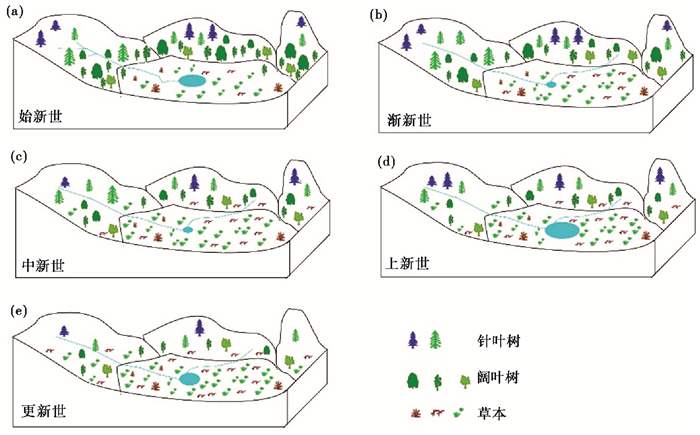
|
图 5 渭河盆地始新世以来植被演替示意图 Fig. 5 Schematicdiagram of vegetation succession since Eocene in the Weihe Basin |
总体而言,古近纪,渭河盆地植被以亚热带常绿阔叶和落叶阔叶混交林为主,气候暖热,季风雏形可能已经形成;新近纪之后,植被逐渐转变为北亚热带针阔叶混交林、暖温带森林草原,气候有变凉变干的趋势;进入第四纪之后,渭河盆地植被以草原为主,气候趋于凉干,并伴随着冷暖波动变化。
对比新生代以来季风降水变化和深海氧同位素[1]变化,可以发现季风降水减少的趋势与全球变冷趋势基本是一致的,表明了全球变冷对构造时间尺度上季风演化的影响。一方面,全球温度降低,使海陆热力差异减小,进而全球水循环减弱,季风降水减弱;另一方面,全球变冷导致冰盖扩张,海平面下降,使陆地和海洋之间的距离增加,从而使季风减弱[2, 5, 8, 10]。除此之外,以高原隆升为代表的构造运动对季风气候演化的影响作用一直被重视[60]。构造抬升导致强烈的化学风化,消耗大量的CO2,导致全球温度降低,影响季风环流变化[13, 60]。Liu等[61]指出在10.0~7.0 Ma左右,北秦岭曾经历大规模、快速的抬升,那么,10.0~7.0 Ma阶段的构造抬升是否也是导致气候变干的原因呢?最近,我们对渭河盆地灞河组花粉研究显示,11.0~10.0 Ma期间,AP/NAP(乔木与非乔木花粉比值)出现几次峰值(图 4),说明存在气候波动事件。然而,在11.0~10.0 Ma期间气温已经出现了较大波动时,而此时秦岭还未开始大规模的构造抬升或是抬升幅度较小。因此,我们认为秦岭构造运动并不是渭河盆地气候变化最主要的影响因素,全球变冷可能对晚中新世东亚季风演化起主导作用。
4 结论通过对已有渭河盆地沉积序列花粉研究资料的集成分析,结合灞河组孢粉记录综合研究,揭示了渭河盆地新生代以来的植被、气候主要变化特征,得到以下初步结论:
(1) 在古近纪渭河盆地花粉含有热带/亚热带植物成分,植被以亚热带常绿阔叶和落叶阔叶混交林、落叶阔叶林为主。新近纪之后,渭河盆地孢粉组合显示亚热带植被花粉含量降低,后期草本花粉含量升高,植被逐渐转变为北亚热带针阔叶混交林、暖温带森林草原。进入第四纪,木本植物花粉以松属为主、耐旱的藜科、蒿属、麻黄属等草本、灌木植物花粉有较高含量,渭河盆地植被向森林草原、稀疏的森林草原、草原演替。
(2) 始新世时渭河盆地生长热带植物树种,气温较高和降水较多,气候暖湿;渐新世时热带-亚热带植物树种略减少,气温和降水比始新世有降低的趋势;中新世植被无热带树种,含有少量亚热带树种,气候温暖湿润;上新世含有极少量亚热带喜热树种,气候较温暖湿润,上新世末期气候开始变干;进入第四纪后气候持续变干,并伴随着显著冷暖(冰期-间冰期)变化。
(3) 新生代以来渭河盆地季风降水逐渐减少,与全球变冷趋势基本一致,揭示了全球变冷对构造时间尺度上亚洲季风演化的影响。
致谢: 感谢贾玉连教授、强小科研究员和编辑部杨美芳老师宝贵的修改意见。
| [1] |
Zachos J C, Dickens G R, Zeebe R E. An Early Cenozoic perspective on greenhouse warming and carbon-cycle dynamics[J]. Nature, 2008, 451(7176): 279-283. DOI:10.1038/nature06588 |
| [2] |
刘东生, 郑绵平, 郭正堂. 亚洲季风系统的起源和发展及其与两极冰盖和区域构造运动的时代耦合性[J]. 第四纪研究, 1998(3): 194-204. Liu Tungsheng, Zheng Mianping, Guo Zhengtang. Initiation and envolution of the Asian monsoon system timely coupled, with the ice-sheet growth and the tectonic movements in Asia[J]. Quaternary Sciences, 1998(3): 194-204. DOI:10.3321/j.issn:1001-7410.1998.03.002 |
| [3] |
Sun X J, Wang P X. How old is the Asian monsoon system?-Palaeobotanical records from China[J]. Palaeogeography, Palaeoclimatology, Palaeoecology, 2005, 222(3-4): 181-222. DOI:10.1016/j.palaeo.2005.03.005 |
| [4] |
Wang P X, Clemens S, Beaufort L, et al. Evolution and variability of the Asian monsoon system:State of the art and outstanding issues[J]. Quaternary Science Reviews, 2005, 24(5): 595-629. |
| [5] |
Guo Z T, Sun B, Zhang Z S, et al. A major reorganization of Asian climate by the Early Miocene[J]. Climate of the Past, 2008, 4(3): 153-174. DOI:10.5194/cp-4-153-2008 |
| [6] |
Roe G H, Ding Q H, Battisti D S, et al. A modeling study of the response of Asian summertime climate to the largest geologic forcings of the past 50 Ma[J]. Journal of Geophysical Research:Atmospheres, 2016, 121(10): 5453-5470. DOI:10.1002/2015JD024370 |
| [7] |
Li X, Zhang R, Zhang Z, et al. Do climate simulations support the existence of East Asian monsoon climate in the Late Eocene?[J]. Palaeogeography, Palaeoclimatology, Palaeoecology, 2017. |
| [8] |
Guo Z T, Ruddiman W F, Hao Q Z, et al. Onset of Asian desertification by 22 Myr ago inferred from loess deposits in China[J]. Nature, 2002, 416(6877): 159-163. DOI:10.1038/416159a |
| [9] |
Jiang H C, Ding Z L. A 20 Ma pollen record of East-Asian summer monsoon evolution from Guyuan, Ningxia, China[J]. Palaeogeography, Palaeoclimatology, Palaeoecology, 2008, 265(1): 30-38. |
| [10] |
郭正堂. 22-8 Ma风尘沉积记录的季风演变历史[M]//丁仲礼, 马福臣, 田均良, 等.中国西部环境演化集成研究.北京: 气象出版社, 2010: 1-19. Guo Zhengtang. History of monsoon evolution recorded by 22-8 Ma Aeolian deposits[M]//Ding Zhongli, Ma Fuchen, Tian Junliang, et al. Study on the Integration of Environmental Evolution in Western China. Beijing: Meteorological Press, 2010: 1-19. |
| [11] |
Lu H, Wang X, Li L. Aeolian sediment evidence that global cooling has driven Late Cenozoic stepwise aridification in Central Asia[J]. Geological Society, London, Special Publications, 2010, 342(1): 29-44. DOI:10.1144/SP342.4 |
| [12] |
Lu H Y, Guo Z T. Evolution of the monsoon and dry climate in East Asia during Late Cenozoic:A review[J]. Science China:Earth Sciences, 2014, 57(1): 70-79. DOI:10.1007/s11430-013-4790-3 |
| [13] |
Ruddiman W F, Kutzbach J E. Forcing of Late Cenozoic Northern Hemisphere climate by plateau uplift in Southern Asia and the American west[J]. Journal of Geophysical Research, 1989, 94(D15): 18409-18427. DOI:10.1029/JD094iD15p18409 |
| [14] |
An Z, Wu G, Li J, et al. Global monsoon dynamics and climate change[J]. Annual Review of Earth and Planetary Sciences, 2015, 43: 29-77. DOI:10.1146/annurev-earth-060313-054623 |
| [15] |
Molnar P, Boos W R, Battisti D S. Orographic controls on climate and paleoclimate of Asia:Thermal and mechanical roles for the Tibetan Plateau[J]. Annual Review of Earth and Planetary Sciences, 2010, 38(1): 77-102. DOI:10.1146/annurev-earth-040809-152456 |
| [16] |
Liu X D, Sun H, Miao Y F, et al. Impacts of uplift of northern Tibetan Plateau and formation of Asian inland deserts on regional climate and environment[J]. Quaternary Science Reviews, 2015, 116: 1-14. DOI:10.1016/j.quascirev.2015.03.010 |
| [17] |
刘思丝, 黄小忠, 强明瑞, 等. 孢粉记录的青藏高原东北部更尕海地区中晚全新世植被和气候变化[J]. 第四纪研究, 2016, 36(2): 247-256. Liu Sisi, Huang Xiaozhong, Qiang Mingrui, et al. Vegetation and climate change during the mid-Late Holocene reflected by the pollen record from Lake Genggahai, northeastern Tibetan Plateau[J]. Quaternary Sciences, 2016, 36(2): 247-256. |
| [18] |
方小敏, 吴福莉, 韩文霞, 等. 上新世-第四纪亚洲内陆干旱化过程——柴达木中部鸭湖剖面孢粉和盐类化学指标证据[J]. 第四纪研究, 2008, 28(5): 874-882. Fang Xiaomin, Wu Fuli, Han Wenxia, et al. Plio-Pleistocene drying process of Asian inland-Sporopollen and salinity records from Yahu section in the central Qaidam Basin[J]. Quaternary Sciences, 2008, 28(5): 874-882. DOI:10.3321/j.issn:1001-7410.2008.05.010 |
| [19] |
胡雅琴, 曹现勇, 赵志军, 等. 西辽河上游全新世早中期环境变化及其对人类活动的影响[J]. 第四纪研究, 2016, 36(3): 530-541. Hu Yaqin, Cao Xianyong, Zhao Zhijun, et al. The palaeoenvironmental and palaeoclimatic reconstruction and the relation with the human activities during the Early and Middle Holocene in the upper Western Liao River region[J]. Quaternary Sciences, 2016, 36(3): 530-541. |
| [20] |
Mosbrugger V, Utescher T, Dilcher D L. Cenozoic continental climatic evolution of Central Europe[J]. Proceedings of the National Academy of Sciences of the United States of America, 2005, 102(42): 14964-14969. DOI:10.1073/pnas.0505267102 |
| [21] |
Jaramillo C, Rueda M J, Mora G. Cenozoic plant diversity in the neotropics[J]. Science, 2006, 311(5769): 1893-1896. DOI:10.1126/science.1121380 |
| [22] |
Palazzesi L, Barreda V. Major vegetation trends in the Tertiary of Patagonia(Argentina):A qualitative paleoclimatic approach based on palynological evidence[J]. Flora, 2007, 202(4): 328-337. DOI:10.1016/j.flora.2006.07.006 |
| [23] |
刘耕武. 我国北方晚第三纪孢粉序列[J]. 古生物学报, 1988, 27(1): 75-85. Liu Gengwu. Sporo-pollen sequence in the Neogene of North China[J]. Acta Palaeontologica Sinica, 1988, 27(1): 75-85. |
| [24] |
王伟铭. 中国南方晚第三纪孢粉植物群的变迁[J]. 微体古生物学报, 1992, 9(1): 81-95. Wang Weiming. Palynofloristic changes in the Neogene of South China[J]. Acta Micropalaeontologica Sinica, 1992, 9(1): 81-95. |
| [25] |
Yao Y F, Bruch A A, Mosbrugger V, et al. Quantitative reconstruction of Miocene climate patterns and evolution in Southern China based on plant fossils[J]. Palaeogeography, Palaeoclimatology, Palaeoecology, 2011, 304(3): 291-307. |
| [26] |
Meng Q T, Bruch A A, Sun G, et al. Quantitative reconstruction of Middle and Late Eocene paleoclimate based on palynological records from the Huadian Basin, Northeastern China:Evidence for monsoonal influence on oil shale formation[J]. Palaeogeography, Palaeoclimatology, Palaeoecology, 2017. DOI:10.1016/j.palaeo.2017.11.036 |
| [27] |
Sun J M, Xu Q H, Liu W M, et al. Palynological evidence for the Latest Oligocene-Early Miocene paleoelevation estimate in the Lunpola Basin, central Tibet[J]. Palaeogeography, Palaeoclimatology, Palaeoecology, 2014, 399(4): 21-30. |
| [28] |
中国科学院植物研究所, 地质部地质研究所新生代孢粉组.陕西蓝田地区新生代古植物学的研究[C]//中国科学院古脊椎动物与古人类研究所.陕西蓝田新生界现场会议论文集.北京: 科学出版社, 1966: 157-182. Institute of Botany, Chinese Academy of Sciences, Cenozoic Palynology Working Group, Institute of Geology, Ministry of Geology. Studies of Cenozoic paleobotany in Lantian region, Shaanxi[C]//Institute of Vertebrate Palaeontology and Palaeoanthropology, Chinese Academy of Sciences. Symposium of the Field Conference on the Cenozoic Group of Lantian, Shaanxi Province. Beijing: Science Press, 1966: 157-182. |
| [29] |
第三普查勘探大队301分队.汾渭盆地石油普查阶段地质成果报告[R]. 1977: 1-129. Third Survey Team 301 Unit. Report on the Geological Results of the Oil Survey in the Fenwei Basin[R]. 1977: 1-129. |
| [30] |
王存诚. 论渭河地堑[J]. 地质学报, 1996, 45(2): 153-164. Wang Cuncheng. On the Weihe Graben[J]. Acta Geologica Sinica, 1996, 45(2): 153-164. |
| [31] |
王斌, 郑洪波, 王平, 等. 渭河盆地新生代地层与沉积演化研究:现状和问题[J]. 地球科学进展, 2013, 28(10): 1126-1135. Wang Bin, Zheng Hongbo, Wang Ping, et al. The Cenozoic strata and depositional evolution of Weihe Basin:Progresses and problems[J]. Advance in Earth Science, 2013, 28(10): 1126-1135. DOI:10.11867/j.issn.1001-8166.2013.10.1126 |
| [32] |
中国科学院中国植被图编辑委员会.中华人民共和国植被图(1:1000000)[Z].北京: 地质出版社, 2007: 74. Editorial Board of Vegetation Map of China, Chinese Academy of Sciences. Vegetation Map of the People's Republic of China(1:1000000)[Z]. Beijing: The Geological Publishing House, 2007: 74. |
| [33] |
刘东生, 丁梦麟, 高福清. 西安蓝田间新生界地层剖面[J]. 地质科学, 1960(4): 199-208. Liu Tungsheng, Ding Menglin, Gao Fuqing. Cenozoic stratigraphic sections between Xi'an and Lantian[J]. Chinese Journal of Geology, 1960(4): 199-208. |
| [34] |
张玉萍, 黄万波, 汤英俊, 等. 陕西蓝田新生界的初步观察[J]. 古脊椎动物与古人类, 1964, 8(2): 134-151. Zhang Yuping, Huang Wanbo, Tang Yingjun, et al. Initial Observations on the Cenozoic group of Lantian, Shaanxi Province[J]. Vertebrata PalAsiatica, 1964, 8(2): 134-151. |
| [35] |
贾兰坡, 张玉萍, 黄万波, 等.陕西蓝田新生界[C]//中国科学院古脊椎动物与古人类研究所.陕西蓝田新生界现场会议论文集.北京: 科学出版社, 1966: 1-31. Jia Lanpo, Zhang Yuping, Huang Wanbo, et al. The Cenozoic group of Lantian, Shaanxi Province[C]//Institute of Vertebrate Palaeontology and Palaeoanthropology, Chinese Academy of Sciences. Symposium of the Field Conference on the Cenozoic Group of Lantian, Shaanxi Province. Beijing: Science Press, 1966: 1-31. |
| [36] |
张玉萍, 黄万波, 汤英俊, 等. 陕西蓝田地区新生界[M]. 北京: 科学出版社, 1978: 1-60. Zhang Yuping, Huang Wanpo, Tang Yingjun, et al. Cenozoic of the Lantian Region, Shaanxi Province[M]. Beijing: Science Press, 1978: 1-60. |
| [37] |
张云翔, 薛祥煦. 陕西蓝田地区新第三纪地层划分的几点讨论[J]. 西北地质科学, 1996, 17(1): 59-62. Zhang Yunxiang, Xue Xiangxu. Discuss on subdivision of Late Miocene in Lantian area, middle of Shaanxi[J]. Northwest Geoscience, 1996, 17(1): 59-62. |
| [38] |
刘护军, 薛祥煦. 对渭河盆地新生界及其年代的讨论[J]. 地球科学与环境学报, 2004, 26(4): 1-5. Liu Hujun, Xue Xiangxu. Discussion on the Cenozoic and its chronology in the Weihe River Basin[J]. Journal of Earth Sciences and Environment, 2004, 26(4): 1-5. DOI:10.3969/j.issn.1672-6561.2004.04.001 |
| [39] |
孙文峰, 鹿化煜, 王逸超, 等. 渭河盆地蓝田始新世红河组沉积物特征和古环境记录[J]. 高校地质学报, 2017, 23(3): 533-544. Sun Wenfeng, Lu Huayu, Wang Yichao, et al. Deposits and palaeoenvironmental record of the Eocene Honghe Formation in Lantian, Weihe Basin, Central China[J]. Geological Journal of China Universities, 2017, 23(3): 533-544. |
| [40] |
王斌, 郑洪波, 何忠, 等. 基于磁性地层的渭河盆地灞河组研究[J]. 高校地质学报, 2014, 20(3): 415-424. Wang Bin, Zheng Hongbo, He Zhong, et al. Study on the Bahe Formation in the Weihe Basin based on magnetostratigraphy[J]. Geological Journal of China Universities, 2014, 20(3): 415-424. |
| [41] |
李智超, 李文厚, 李永项, 等. 渭河盆地新生代沉积相研究[J]. 古地理学报, 2015, 17(4): 529-540. Li Zhichao, Li Wenhou, Li Yongxiang, et al. Sedimentary facies of the Cenozoic in Weihe Basin[J]. Journal of Palaeogeography, 2015, 17(4): 529-540. |
| [42] |
周明镇.陕西蓝田地区第三纪哺乳类动物群[C]//中国地质科学院地层古生物论文集编委会.地层古生物论文集(第七辑).北京: 地质出版社, 1978: 98-108. Chow Minchen. Tertiary mammalian faunas of the Lantian district, Shensi[C]//Editorial Committee of Professional Papers of Stratigraphy and Palaeotology, Chinese Academy of Geological Sciences. Professional Papers of Stratigraphy and Palaeotology, No.7. Beijing: Geological Publishing House, 1978: 98-108 |
| [43] |
Wang B, Zheng H B, He Z, et al. Middle Miocene eolian sediments on the southern Chinese Loess Plateau dated by magnetostratigraphy[J]. Palaeogeography, Palaeoclimatology, Palaeoecology, 2014, 411: 257-266. DOI:10.1016/j.palaeo.2014.07.007 |
| [44] |
孙秀玉, 范永绣, 邓茨兰, 等.渭河盆地新生代孢粉组合[C].中国地质科学院地质研究所文集, 1980, 1(1): 84-109. Sun Xiuyu, Fan Yongxiu, Deng Cilan, et al. Cenozoic sporo-pollen assemblage of the Weihe Basin, Shaanxi[C]. Proceedings of Institute of Geology, Chinese Academy of Geological Sciences, 1980, 1(1): 84-109. |
| [45] |
Kaakinen A, Sonninen E, Lunkka J P. Stable isotope record in paleosol carbonates from the Chinese Loess Plateau:Implications for Late Neogene paleoclimate and paleovegetation[J]. Palaeogeography, Palaeoclimatology, Palaeoecology, 2006, 237(2-4): 359-369. DOI:10.1016/j.palaeo.2005.12.011 |
| [46] |
童国榜, 张俊牌, 刘明建, 等. 渭河盆地距今200-300万年古植被及第四纪下限的讨论[J]. 海洋地质与第四纪地质, 1989, 9(4): 86-96. Tong Guobang, Zhang Junpai, Liu Mingjian, et al. Palaeovegetation(2-3 Ma BP)and lower boundary of Quarternary in Weihe River Basin, Shaanxi[J]. Marine Geology & Quaternary Geology, 1989, 9(4): 86-96. |
| [47] |
阎永定. 卤阳湖区的环境变迁及其开发利用[J]. 陕西地质, 1988, 6(1): 65-75. Yan Yongding. The environmental changes exploitation and utilization of the Luyang Lake Basin[J]. Geology of Shanxi, 1988, 6(1): 65-75. |
| [48] |
Han J, Fyfe W S, Longstaffe F J, et al. Pliocene-Pleistocene climatic change recorded in fluvio lacustrine sediments in Central China[J]. Palaeogeography, Palaeoclimatology, Palaeoecology, 1997, 135(1): 27-39. |
| [49] |
刘俊峰, 苏英.陕西蓝田地区850 ka以来的植被与气候演变[M]//刘东生.黄土第四纪地质全球变化(4).北京: 科学出版社, 1996: 53-62. Liu Junfeng, Su Ying, Vegetation and climate change since 850 ka in Lantian district, Shaanxi Province[M]//Liu Tunsheng. Global Changes and Quaternary Geology and Loess (4). Beijing: Science Press, 1996: 53-62. |
| [50] |
孙湘君, 宋长青, 王琫瑜, 等. 黄土高原南缘10万年以来的植被——陕西渭南黄土剖面的花粉记录[J]. 科学通报, 1995, 40(13): 1222-1224. Sun Xiangjun, Song Changqing, Wang Bengyu, et al. Vegetation of Southern Chinese Loess Plateau since 100 ka-Pollen record of loess section in Weinan, Shaanxi[J]. Chinese Science Bulletin, 1995, 40(13): 1222-1224. DOI:10.3321/j.issn:0023-074X.1995.13.020 |
| [51] |
孙湘君. 陕西渭南北庄村晚更新世晚期古植被的再研究[J]. 第四纪研究, 1989(2): 177-189. Sun Xiangjun. A restudy of the Latest Pleistocene paleovegetation at Beizhuangcun, Shaanxi Province, Northern China[J]. Quaternary Sciences, 1989(2): 177-189. DOI:10.3321/j.issn:1001-7410.1989.02.008 |
| [52] |
李秉成. 10000 a B.P.关中蓝田的植被和气候[J]. 吉林大学学报(地球科学版), 2010, 40(1): 109-113. Li Bingcheng. Vegetation and climate since 10000 a B.P. in Lantian of Guanzhong area, Shaanxi Province[J]. Journal of Jilin University(Earth Science Edition), 2010, 40(1): 109-113. |
| [53] |
Shang X, Li X Q. Holocene vegetation characteristics of the southern Loess Plateau in the Weihe River valley in China[J]. Review of Palaeobotany and Palynology, 2010, 160(1-2): 46-52. DOI:10.1016/j.revpalbo.2010.01.004 |
| [54] |
赵景波, 侯甬坚, 杜娟, 等. 关中平原全新世环境演变[J]. 干旱区地理, 2003, 26(1): 17-22. Zhao Jingbo, Hou Yongjian, Du Juan, et al. Holocene environmental changes in the Guanzhong Plain[J]. Arid Land Geography, 2003, 26(1): 17-22. DOI:10.3321/j.issn:1000-6060.2003.01.004 |
| [55] |
刘明健, 王静敏, 杜乃秋, 等. 陕西华阴N3钻孔孢粉分析及对自然环境变化的初步探讨[J]. 植物学通报(改名为:植物学报), 1984, 1(2): 51-54. Liu Mingjian, Wang Jingmin, Du Naiqiu, et al. Preliminary discussion on pollen analysis and environmental change of N3 drilling in Huayin, Shaanxi[J]. Chinese Bulletin of Botany, 1984, 1(2): 51-54. |
| [56] |
王伴月.陕西蓝田地区始新世晚期几种奇蹄类化石[C]//中国地质科学院地层古生物论文集编委会.地层古生物论文集(第七辑).北京: 地质出版社, 1978: 118-121. Wang Banyue. Perissodactyla from Late Eocene in Lantian area, Shaanxi[C]//Editorial Committee of Professional Papers of Stratigraphy and Palaeotology, Chinese Academy of Geological Sciences. Professional Papers of Stratigraphy and Palaeotology, No.7. Beijing: Geological Publishing House, 1978: 118-121. |
| [57] |
Li B F, Sun D H, Wang X, et al. δ18O andδ13C records from a Cenozoic sedimentary sequence in the Lanzhou Basin, Northwestern China:Implications for palaeoenvironmental and palaeoecological changes[J]. Journal of Asian Earth Sciences, 2016, 125: 22-36. DOI:10.1016/j.jseaes.2016.05.010 |
| [58] |
Hoorn Carina, Straathof Julia, Abels Hemmo A, et al. A Late Eocene palynological record of climate change and Tibetan Plateau uplift(Xining Basin, China)[J]. Palaeogeography, Palaeoclimatology, Palaeoecology, 2012, 344-345(8): 16-38. |
| [59] |
赵秀丽, 张春霞, 吴海斌, 等. 西宁盆地始新世/渐新世过渡期孢粉植物群特征及其意义[J]. 第四纪研究, 2015, 35(6): 1489-1499. Zhao Xiuli, Zhang Chunxia, Wu Haibin, et al. Significance of Eocene-Oligocene transition on pollen record from Xining Basin, China[J]. Quaternary Sciences, 2015, 35(6): 1489-1499. |
| [60] |
Molnar P, England P, Martinod J. Mantle dynamics, uplift of the Tibetan Plateau and the Indian monsoon[J]. Reviews of Geophysics, 1993, 31(4): 357-396. DOI:10.1029/93RG02030 |
| [61] |
Liu J H, Zhang P Z, Lease R O, et al. Eocene onset and Late Miocene acceleration of Cenozoic intracontinental extension in the north Qinling range-Weihe graben:Insights from apatite fission track thermochronology[J]. Tectonophysics, 2013, 584(1): 281-296. |
2 Nanjing Institute of Geology and Palaeontology, Chinese Academy of Sciences, Nanjing 210008, Jiangsu)
Abstract
Under the background of global cooling during Cenozoic, the main feature of Asian environmental change is the formation and evolution of Asian Monsoon. The Weihe Basin, known as the Weihe graben Basin or Guanzhong Plain, is located in the middle of Shaanxi Province and between Qinling Mountains and the Weibei Mountains. The Weihe Basin has a continuous Cenozoic sedimentary sequence, which provides an excellent archive for studying history of vegetation evolution and exploring the characteristics of the Asian monsoon variation in Cenozoic. Tertiary strata of the Weihe Basin are composed of Honghe, Bailuyuan, Lengshuigou, Koujiacun, Bahe, Lantian and Sanmen formations. We use the pollen data of Xiangcheng Formation in Lushi Basin as an equivalent of Honghe Formation to reconstruct vegatation of Middle to Late Eocene. The data of Xiangcheng Formation, Bailuyuan Formation, Lengshuigou Formation, Lantian Formation and Sanmen Formation are from previous studies and data of Bahe Formation is from our study. By analyzing and integrating the pollen data, this paper reconstructs the paleovegetation and paleoclimate change of the Weihe Basin in Cenozoic. The vegetation was deciduous broad-leaved forest containing tropical and subtropical trees in Middle to Late Eocene, which indicate the climate was very warm and wet. During the Oligocene, vegetation was a deciduous broadleaf forest containing some evergreen tree species, the climate was warm and wet. The vegetation was mainly deciduous broad-leaved tree and the climate was warm and humid during the Early Miocene. In the Late Miocene, vegetation was mainly forest and grassland, and the temperature and precipitation were slightly lower than the Early Miocene. The vegetation was deciduous broad-leaved forest and coniferous mixed forest during the Pliocene. In the Late Pliocene, the climate shifted to dry and cool. Since the Early Pleistocene, the vegetation was replaced by the forest and grassland, the steppe and forest, and the grassland. During the Eocene, tropical plant species were grown in the Weihe Basin. The tropical and subtropical trees decreased slightly during the Oligocene, and the temperature and precipitation decrease compared with the Eocene. The vegetation in Miocene was non-tropical, containing a small number of subtropical trees, and the climate was warm and wet. The vegetation of the Pliocene contains a very small number of subtropical heat-loving trees, which indicate the climate was warm and humid, and the climate was dry at the end of the Pliocene. In the Quaternary, the climate was general dry, and accompanied by significant changes in temperature during glacial-interglacial alternations. In the Cenozoic era, the monsoon precipitation decreased gradually, which was consistent with the global cooling trend. All of these observation reveal the global cooling might be a major driver for the phase weakening of Asian monsoon at tectonic time scale. 2018, Vol.38
2018, Vol.38

